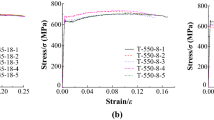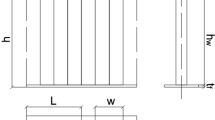Abstract
Deflection of the steel I-sections is an important phenomenon that needs to be taken into account to ensure that the serviceability limit state criteria of the Australian Standards are met. The method that is widely used to calculate the deflection of steel I-sections is by the use of existing formulae that only accommodate the bending stiffness of the beams. A numerical investigation is performed in this study to find the contribution of shear effects in the final deflection of the Welded-Beams (WB) and Welded-Columns (WC). The numerical analyses were carried out in SAP2000 and numerical model was first validated using the experimental results of welded plate girders. The model was then used to analyse simply supported WB and WC sections under uniformly distributed load (UDL) with varying span lengths. The results of the numerical analyses are reported in this study which compare the mid-span deflection values from the simply supported deflection formula with the numerical model deflection values. The data acquired from the numerical analyses were used to establish a span to depth ratio for WB and WC sections below which the shear deflection becomes significant. The analysis of the results obtained from the numerical investigation suggests that a predication error begins to emerge in the result that is acquired from flexure deflection formulae at a certain span-depth ratio.











Similar content being viewed by others
References
AS4100. (1998). Steel structures. Sydney: Standard Australia.
American Institute of Steel Construction. (2003). Design guide 3: Serviceability design considerations for steel buildings (2nd ed.). Chicago: American Institute of Steel Construction.
American Institute of Steel Construction. (2016). Specification for structural steel buildings ANSI/AISC 360-16. Chicago: American Institute of Steel Construction.
Bender, D. A., & Skaggs, T. D. (1992). Shear deflection of composite wood beams. Wood and Fiber Science, 27, 327–338.
British Standards Institution. (2000). Structural use of steelwork in building, Part 1: Code of practice for design – rolled and welded sections. London: British Standards Institution.
Computers and Structures 2018, CSI Analysis Reference Manual for SAP2000, Berkeley, California. <http://docs.csiamerica.com/manuals/misc/CSI%20Analysis%20Reference%20Manual%202011-12.pdf>.
Esendemir, U. (2019). Derivation of equations for flexure and shear deflections of simply supported beams. Journal of Engineering Sciences, 15(2), 187–193.
Far, H., Saleh, A., & Firouzianhaji, A. (2017). A simplified method to determine shear stiffness of thin walled cold formed steel storage rack frames. Journal of Constructional Steel Research, 138, 799–805.
Fatahi, B., & Tabatabaiefar, H. R. (2014). Effects of soil plasticity on seismic performance of mid-rise building frames resting on soft soils. Advances in Structural Engineering, An International Journal, 17(10), 1387–1402.
Haydar, H., Far, H., & Saleh, A. (2018). Portal steel trusses versus portal steel frames for long- span industrial buildings. Steel Construction, 11(3), 205–217.
Hot Rolled and Structural Steel Products, Welded Beams, viewed May 2018, https://www.libertyonesteel.com/media/165356/seventh-edition-hot-rolled-and-structural-steel-productsseventh-edition-hot-rolled-and-structural-steel-products.pdf
Ingkiriwang, Y., & Far, H. (2018). Numerical investigation of the design of single-span steel portal frames using the effective length and direct analysis methods. Steel Construction, 11(3), 184–191.
Iyer, H. (2005). The effects of shear deformation in rectangular and wide flange sections. Virginia: Virginia Polytechnic Institute and State University.
Karttunen, A. T., Romanoff, J., & Reddy, J. N. (2016). Exact microstructure-dependent Timoshenko beam element. International Journal of Mechanical Sciences, 112, 35–42.
Kitis, L., Schramm, U., Kang, W., & Pilkey, W. D. (1994). On the shear deformation coefficient in beam theory. Finite Elements in Analysis and Design, 16, 141–162.
Lignola, G. P., Spena, F. R., Prota, A., & Manfredi, G. (2017). ‘Exact stiffness-matrix of two nodes Timoshenko beam on elastic medium An analogy with Eringen model of nonlocal Euler-Bernoulli nanobeams. Computers and Structures, 182, 556–570.
Lin, X., Far, H., & Saleh, A. (2019). Structural behaviour and mechanical properties of welded steel I-girders with corrugated webs. International Journal of Steel Structures, 19(4), 1342–1352.
Megson, T. H. G. (2014). Structural and stress analysis (3rd ed.). UK: Butterworth-Heinemann.
Mingmin, T., Lichao, S., & Shui, W. (2013). Study of shear deformation’s influence on deflection of continuous composite box-girder bridge with corrugated steel webs. Applied Mechanics and Materials, 275, 961–965.
Saleh, A., Far, H., & Mok, L. (2018). Effects of different support conditions on experimental bending strength of thin walled cold formed steel storage upright frames. Journal of Constructional Steel Research, 150, 1–6.
Saliba, N., & Gardner, L. (2012). Experimental study of the shear response of lean duplex stainless steel plate girders. Engineering Structures, 46, 375–391.
Salmon, C. G., Johnson, J. E., & Malhas, F. A. (1990). Steel structures: Design and behavior: emphasizing load and resistance factor design (3rd ed.). New York: Harper & Row.
Schramm, U., Kitis, L., Kang, W., & Pilkey, W. D. (1994). On the shear deformation coefficient in beam theory. Finite Elements in Analysis and Design, 16, 141–162.
Standards, E. (2006). Eurocode 3: Design of steel structures, EN 1993-1-5:2006. Brussels: European Standards.
Stramandinoli, R. S. B., & Rovere, H. L. L. (2012). FE model for nonlinear analysis of reinforced concrete beams considering shear deformation. Engineering Structures, 35, 244–253.
Tabatabaiefar, H., & Clifton, T. (2016). Significance of considering soil-structure interaction effects on seismic design of unbraced building frames resting on soft. Australian Geomechnics Journal, 51(1), 55–64.
Tabatabaiefar, H. R., Fatahi, B., & Samali, B. (2012). Finite difference modelling of soil-structure interaction for seismic design of moment resisting building frames. Australian Geomechanics Journal, 47(3), 113–119.
Author information
Authors and Affiliations
Corresponding author
Additional information
Publisher's Note
Springer Nature remains neutral with regard to jurisdictional claims in published maps and institutional affiliations.
Rights and permissions
About this article
Cite this article
Kamali, S., Far, H. Numerical Investigation on Shear Deflection of Steel Welded I Sections with Varying Span to Depth Ratios. Int J Steel Struct 21, 393–407 (2021). https://doi.org/10.1007/s13296-020-00445-y
Received:
Accepted:
Published:
Issue Date:
DOI: https://doi.org/10.1007/s13296-020-00445-y












